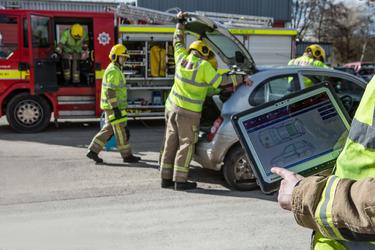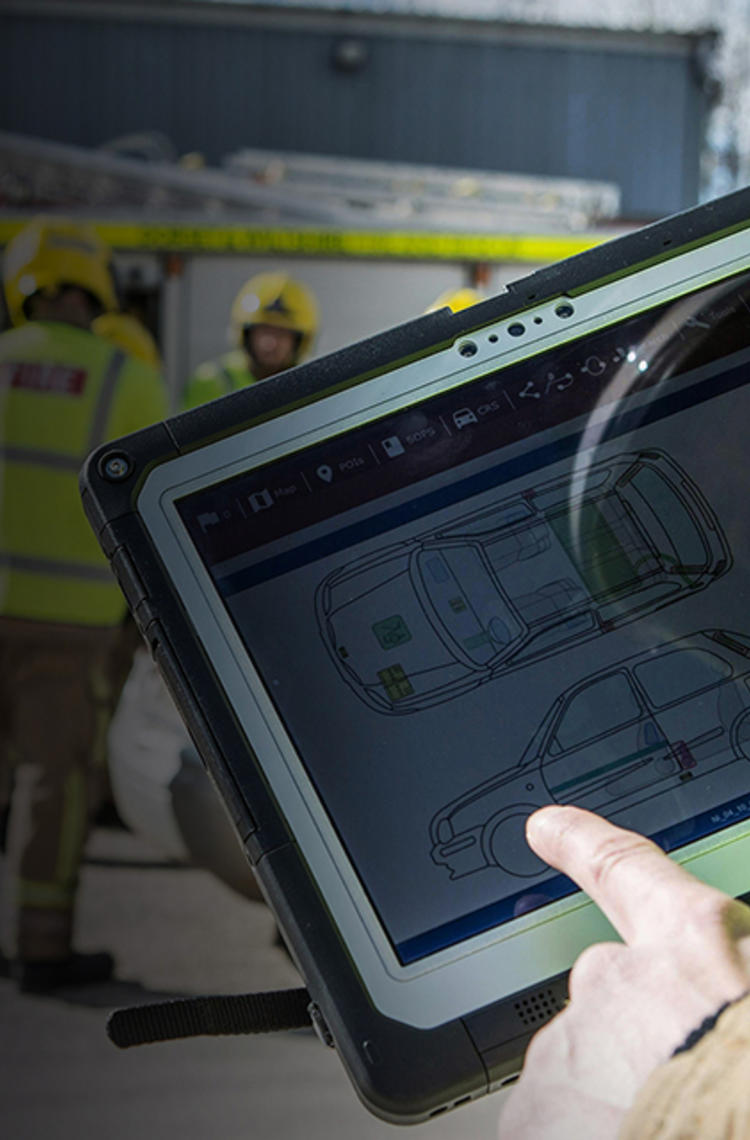Efficiency is paramount for fire and rescue services. They need to be able to quickly assess an incident and take the appropriate action. In the UK, SAFEcommand – a digital solution from Airbus – gives them vital insights to keep the public safe.
The hot and dry summer months also make for a busy season for firefighters. In 2022, this was particularly noticeable as England experienced the hottest summer on record and the driest year since 1976. Along with that came an increase in the number of fires: between July and September 2022, England's fire and rescue services attended 68,427 fires – more than in any other three-month period since 2011.
Avon Fire & Rescue Service – covering the four unitary authorities of Bath & North East Somerset, Bristol, North Somerset and South Gloucestershire – was no exception. In total, the service responded to 1,167 fires during the summer heatwave, a 70 per cent increase on the same period in 2021.
Situational awareness is key
Sean Perry knows the added pressure this puts on fire and rescue services. He has been working for Avon Fire & Rescue Service for 20 years now; currently he is the Digital Project Manager. "Every call is different, and an increasing number of incidents means that efficiency becomes even more valuable. Situational awareness is the vital factor here.”

Sean Perry has been with the Avon Fire & Rescue Service for 20 years. "We rely on SAFEcommand for every incident,” he says.
Avon Fire & Rescue is among the 70 per cent of mainland UK fire and rescue services that rely on SAFEcommand. The digital solution provides firefighters and other emergency services with key information to manage an incident.
With SAFEcommand, the team has a clear picture of what to expect even before they arrive at the scene. Using a portable device, they have all the incident information at their fingertips. "We rely on SAFEcommand for every incident,” Sean Perry says. “It tells the driver, the incident commander and the crews exactly where the incident is. It also tells the incident commander about potential risks at the site and provides additional operational information such as the location of fire hydrants. This is invaluable in planning the best possible course of action.”
Improving coordination
How does this work in practice? During last year's heatwave, for instance, the Avon Fire & Rescue Service had to deal with an increase in wildfires. "We had large areas of countryside and farmland affected," Sean Perry recalls.
When it comes to fighting wildfires, good coordination is key as crews are spread out over a large area. With SAFEcommand, incident commanders were able to map these areas and divide them into different sectors. “This gave commanders a holistic view of the situation, with a direct visual representation of the incident area and the corresponding operational response,” Sean Perry says. “It was much more effective than any coordination by radio communication."
Another important factor is that the information in SAFEcommand is always up-to-date for everyone. "When you divide a location into sectors on the mapping system, that visual information is passed on to every other device using SAFEcommand," Sean Perry explains. And when units arrive on the scene, all their information is also recorded in the system. "At any given moment, you can see how many firefighters are at the scene, where they are and what sector they are in."
“SAFEcommand gives commanders a holistic view of the situation, with a direct visual representation of the incident area and the corresponding operational response.”
Sean Perry, Digital Project Manager Avon Fire & Rescue Service
Saving lives, protecting firefighters
Improving coordination is only one aspect – after all, a fire and rescue service has to ensure public safety in various situations without putting its own personnel at risk. SAFEcommand also proves crucial in this regard.
Take a car accident, for example: firefighters need to act quickly and purposefully to rescue passengers. SAFEcommand provides the rescue team with all the important information about the type of vehicle and the risks it might pose. "When you enter a number plate into SAFEcommand, it tells you everything about the make and model of the car – where the roll bars are, where the airbags are, where high voltage cables are. All at the touch of a few buttons," Sean Perry explains.

SAFEcommand provides fire and rescue services with vital incident information, for example when helping in a car accident.
Firefighters also know exactly how to respond to certain hazards. "Say we have an incident with an acetylene cylinder,” Sean Perry says. “SAFEcommand will tell frontline firefighters how to deal with the situation according to the official guidelines. They will know how long the cylinder should be cooled, or how big the hazard zone should be around it. This way firefighters do not put themselves in unnecessary danger and can act quickly.”
Digitalisation as the new standard
Nowadays, digital solutions such as SAFEcommand are an integral part of daily operations at fire and rescue services. Long gone are the days, when important information was written on small laminated cards that were stored in a box in the appliance. Gone are also the days, where they had to be reprinted periodically as they became out of date.
As Sean Perry puts it: "It's unimaginable now, but when I started my career in firefighting, the appliance driver would look at a paper map if he or she was unfamiliar with the area. Now we have vehicle information, chemical information, weather information – all coming in in real time and allowing us to act quickly and efficiently.”
